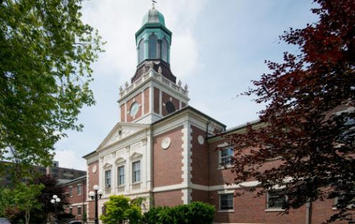
I'm going to make a little deviation from the bulk of the "Welcome to..." stories you see below, which mostly focus on South Side Chicago neighborhoods (the exceptions are Rosemont, in Chicago's northwest suburbs, and Park Forest, in the south suburbs).
Other entries in the occasional series observing Chicagoland places and spaces:
Welcome to Marquette Park
Welcome to Woodlawn
Welcome to Park Forest
Welcome to Ashburn (via WBEZ)
Welcome To South Chicago
Welcome To Mount Greenwood
Welcome To Rosemont
Welcome To The South Side, JRW Style
We're going to venture to the city's West Side. Today's entry, Austin, has an interesting origin story.
Austin sits on Chicago's far West Side, about seven miles directly west of the Loop. It borders the suburban communities of Oak Park and Cicero to its west and south, respectively, with Berwyn located just to the southwest. Really, Austin's story is intimately connected to the other three communities. Following the Civil War, all were united as unincorporated areas within the much larger Cicero Township.
The 1870's and 1880's saw Cicero Township grow immensely, just like the entire Chicago region. Commuter rail provided by the Chicago & Northwestern Railroad and the Lake Street Elevated provided easy access to newly developed "streetcar suburbs" for Loop workers. Austin became the largest community in Cicero Township and its residents dominated township politics. Austin had a plurality of the population in the township, but not a majority, and the residents of Cicero, Berwyn and Austin's neighbor Oak Park, seethed at Austin's leadership. They devised a plan.
Before getting into the plan, let's look at Cicero Township circa 1895. All four communities were early suburbs that boasted tree-lined streets with plentiful single-family homes, with a mix of small apartment buildings thrown in. Each had residential densities that didn't match the intensity of what was seen in Chicago at the time, but clearly was much more intensely built than today's conventional suburban development. Commercial development occurred along streetcar or commuter rail corridors like Madison, Lake Street and Chicago Avenue. With a strong grid pattern and a mix of housing types, the area had broad appeal. All four of Cicero Township's communities prospered.
The biggest difference between them, however, was class. Cicero and Berwyn early on developed a strong manufacturing/working class character, and became a manufacturing center (Cicero) and manufacturing bedroom community (Berwyn). Austin became a solidly middle class community that was becoming a favored destination for new immigrants to the area, just like in Cicero and Berwyn. Oak Park was an upper-middle class enclave.
To the east, Chicago was on an annexation binge; it was trying to eclipse New York as the nation's largest city. Cicero, Berwyn and Oak Park wanted to maintain their independence, but were thwarted by the Austin residents' township leadership. The last straw was the proposed extension of the Lake Street Elevated line to Austin Boulevard, Oak Park's eastern border and Austin's western border, in 1898. Austin favored the extension; the rest of Cicero Township did not.
So Oak Park, Cicero and Berwyn leaders, led by Oak Park, petitioned to annex a portion of the township -- Austin -- to Chicago. Annexation had to be approved by a majority of voters within the township, and the Austin leadership was convinced there weren't enough votes to split them off from the rest of the township. A referendum was held in April 1899. Indeed, annexation was soundly defeated in Austin. However, it was overwhelmingly approved in the other three communities, surpassing the total "no" vote in Austin.
Oak Park, Cicero and Berwyn traded Austin to Chicago for their own independence.
For the next 50 years or so, that meant virtually nothing in terms of each community's development. Austin, Berwyn, Cicero and Oak Park continued on the paths already established by the late 19th century. Austin and Berwyn remained middle class bedroom suburban-ish communities, Cicero was a hub of manufacturing jobs and working-class neighborhoods, and Oak Park was still an upper-middle class enclave.
Read the rest of this piece at Corner Side Yard Blog.
Pete Saunders is a writer and researcher whose work focuses on urbanism and public policy. Pete has been the editor/publisher of the Corner Side Yard, an urbanist blog, since 2012. Pete is also an urban affairs contributor to Forbes Magazine’s online platform. Pete’s writings have been published widely in traditional and internet media outlets, including the feature article in the December 2018 issue of Planning Magazine. Pete has more than twenty years’ experience in planning, economic development, and community development, with stops in the public, private and non-profit sectors. He lives in Chicago.
Photo: Austin Town Hall in Chicago's Austin neighborhood. Source: chicagoparkdistrict.org












